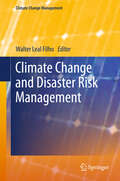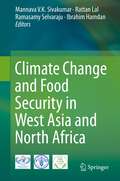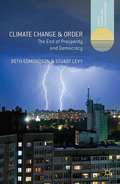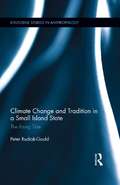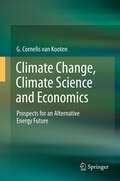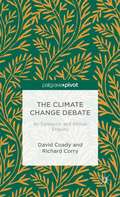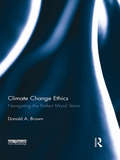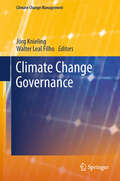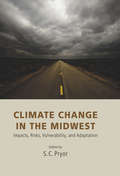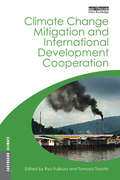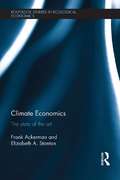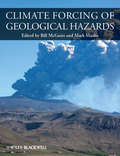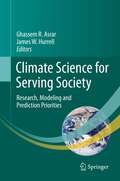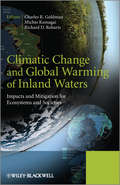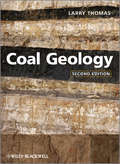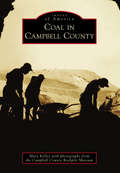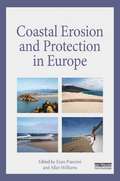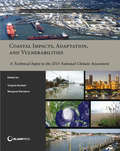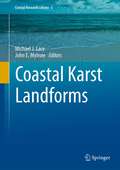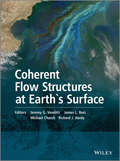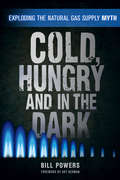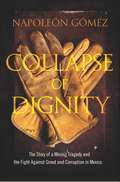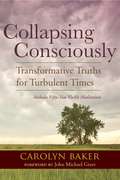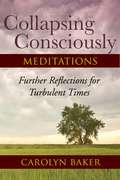- Table View
- List View
Climate Change and Disaster Risk Management (Climate Change Management #0)
by Walter Leal FilhoThere has been some degree of reluctance in the past to consider disaster risk management within the mainstream of adaptation to climate variability and climate change. However, there is now wide recognition of the need to incorporate disaster risk management concerns in dealing with such phenomena. There is also a growing awareness of the necessity for a multi-sectoral approach in managing the effects of climate variability and climate change, since this can lead to a significant reduction of risk. This book presents the latest findings from scientific research on climate variation, climate change and their links with disaster risk management. It showcases projects and other initiatives in this field that are being undertaken in both industrialised and developing countries, by universities and scientific institutions, government bodies, national and international agencies, NGOs and other stakeholders. Finally, it discusses current and future challenges, identifying opportunities and highlighting the still unrealised potential for promoting better understanding of the connections between climate variation, climate change and disaster risk management worldwide.
Climate Change and Food Security in West Asia and North Africa
by Rattan Lal Mannava Sivakumar Ibrahim Hamdan Ramasamy SelvarajuThe countries of West Asia and North Africa (WANA) have long had the challenge of providing sustainable livelihoods for their populations in the fragile ecosystems of semi-arid and arid areas. Climate change is already a reality in WANA and it places additional constraints on the already fragile ecosystems of dry areas and limited natural resources in WANA. A comprehensive and integrated approach to planning and implementing the climate change adaptation strategies across the wide range of agro-ecosystems in different countries in WANA could help both the planners and the local communities to deal effectively with the projected impacts and also contribute to overall sustainability of agricultural production systems. This book addresses the important issue of climate change and food security in West Asia and North Africa and presents the appropriate strategies which could help in the development of new policies to better adapt agriculture production systems and enhance food security in WANA.
Climate Change and Order
by Beth Edmondson Stuart LevyBeth Edmondson and Stuart Levy examine why it is so difficult for the international community to respond to global climate change. In doing so, they analyse and explain some of the strategies that might ultimately provide the foundations for appropriate responses.
Climate Change and Tradition in a Small Island State: The Rising Tide (Routledge Studies in Anthropology #13)
by Peter Rudiak-GouldThe citizens of the Marshall Islands have been told that climate change will doom their country, and they have seen confirmatory omens in the land, air, and sea. This book investigates how grassroots Marshallese society has interpreted and responded to this threat as intimated by local observation, science communication, and Biblical exegesis. With grounds to dismiss or ignore the threat, Marshall Islanders have instead embraced it; with reasons to forswear guilt and responsibility, they have instead adopted in-group blame; and having been instructed that resettlement is necessary, they have vowed instead to retain the homeland. These dominant local responses can be understood as arising from a pre-existing, vigorous constellation of Marshallese ideas termed "modernity the trickster": a historically inspired narrative of self-inflicted cultural decline and seduction by Euro-American modernity. This study illuminates islander agency at the intersection of the local and the global, and suggests a theory of risk perception based on ideological commitment to narratives of historical progress and decline.
Climate Change, Climate Science and Economics: Prospects for an Alternative Energy Future
by G. Cornelis van KootenThis volume enables readers to understand the complexity associated with climate change policy and the science behind it. For example, the author describes the criticism and defense of the widely known "hockey stick" temperature graph derived from combining instrumental data and proxy temperature indications using tree ring, ice core and other paleoclimatic data. Readers will also learn that global warming cannot easily be avoided by reducing CO2 and other greenhouse gas emissions in rich countries. Not only is emissions reduction extremely difficult in rich countries, but demands such as the UN mandate to improve the lives of the poorest global citizens cannot be satisfied without significantly increasing global energy use, and CO2 emissions. Therefore, the author asserts that climate engineering and adaptation are preferable to mitigation, particularly since the science is less than adequate for making firm statements about the Earth's future climate. Readers will also learn that global warming cannot easily be avoided by reducing CO2 and other greenhouse gas emissions in rich countries. Not only is emissions reduction extremely difficult in rich countries, but demands such as the UN mandate to improve the lives of the poorest global citizens cannot be satisfied without significantly increasing global energy use, and CO2 emissions. Therefore, the author asserts that climate engineering and adaptation are preferable to mitigation, particularly since the science is less than adequate for making firm statements about the Earth's future climate.
The Climate Change Debate: An Epistemic and Ethical Enquiry
by David Coady Richard CorryOf the two kinds of philosophical questions - epistemic and ethical - raised by the public debate about climate change, professional philosophers have dealt almost exclusively with the ethical. This book is the first to address both and examine the relationship between them.
Climate Change Ethics: Navigating the Perfect Moral Storm
by Donald A. BrownClimate change is now the biggest challenge faced by humanity worldwide and ethics is the crucial missing component in the debate about what to do about this enormous threat. This book examines why thirty-five years of discussion of human-induced warming has failed to acknowledge fundamental ethical concerns, and subjects climate change’s most important policy questions to ethical analysis. This book examines why ethical principles have failed to gain traction in policy formation and recommends specific strategies to ensure that climate change policies are consistent with ethical principles. Because climate change is a global problem that requires a global solution and given that many nations refuse participation due to perceived inequities in proposed international solutions, this book explains why ensuring that nations, sub-national governments, organizations, businesses and individuals acknowledge and respond to their ethical obligations is both an ethical and practical mandate. This book is the first of its kind to go beyond a mere account of relevant ethical questions to offer a pragmatic guide on how to make ethical principles influential in formulating the world’s response to climate change. Written by Donald A. Brown, a leading voice in the field, it should be of interest to policy makers, and those studying environmental policy, climate change policy, international relations, environmental ethics and philosophy.
Climate Change Geoengineering
by Wil C. G. Burns Andrew L. StraussThe international community is not taking the action necessary to avert dangerous increases in greenhouse gases. Facing a potentially bleak future, the question that confronts humanity is whether the best of bad alternatives may be to counter global warming through human-engineered climate interventions. In this book, eleven prominent authorities on climate change consider the legal, policy, and philosophical issues presented by geoengineering. The book asks: When, if ever, are decisions to embark on potentially risky climate modification projects justified? If such decisions can be justified, in a world without a central governing authority, who should authorize such projects and by what moral and legal right? If states or private actors undertake geoengineering ventures absent the blessing of the international community, what recourse do the rest of us have?
Climate Change Governance (Climate Change Management)
by Walter Leal Filho Jörg KnielingClimate change is a cause for concern both globally and locally. In order for it to be tackled holistically, its governance is an important topic needing scientific and practical consideration. Climate change governance is an emerging area, and one which is closely related to state and public administrative systems and the behaviour of private actors, including the business sector, as well as the civil society and non-governmental organisations. Questions of climate change governance deal both with mitigation and adaptation whilst at the same time trying to devise effective ways of managing the consequences of these measures across the different sectors. Many books have been produced on general matters related to climate change, such as climate modelling, temperature variations, sea level rise, but, to date, very few publications have addressed the political, economic and social elements of climate change and their links with governance. This book will address this gap. Furthermore, a particular feature of this book is that it not only presents different perspectives on climate change governance, but it also introduces theoretical approaches and brings these together with practical examples which show how main principles may be implemented in practice.
Climate Change in the Midwest
by Sara C. PryorThe research presented in this volume focuses on identifying and quantifying the major vulnerabilities to climate change in the Midwestern United States. By providing state-of-the-art spatially disaggregated information regarding the historical, current, and possible future climate within the region, the contributors assess the risks and susceptibility of the critical socio-economic and environmental systems. Key sectors discussed are agriculture, human health, water, energy and infrastructure, and the vulnerabilities that may be amplified under current climate trajectories. The book also considers the challenges and opportunities to develop local and regional strategies for addressing the risks posed by climate change in the context of developing an integrative policy for the region.
Climate Change Mitigation and Development Cooperation (Earthscan Climate)
by Ryo Fujikura Tomoyo ToyotaThis is a companion book to Earthscan’s 2010 book Climate Change Adaptation and International Development. This book consists of summarised case studies looking at climate change mitigation specifically in Asia, the region producing the most greenhouse gas emissions. It examines international development from the perspective of climate change mitigation and looks at how international communities and donors support developing nations by funding, technical assistance and capacity building.
Climate Economics: The State of the Art (Routledge Studies in Ecological Economics)
by Frank Ackerman Elizabeth A. StantonClimate science paints a bleak picture: The continued growth of greenhouse gas emissions is increasingly likely to cause irreversible and catastrophic effects. Urgent action is needed to prepare for the initial rounds of climatic change, which are already unstoppable. While the opportunity to avert all climate damage has now passed, well-designed mitigation and adaptation policies, if adopted quickly, could still greatly reduce the likelihood of the most tragic and far-reaching impacts of climate change. Climate economics is the bridge between science and policy, translating scientific predictions about physical systems into projections about economic growth and human welfare that decision makers can most readily use but it has too often consisted of an overly technical, academic approach to the problem. Getting climate economics right is not about publishing the cleverest article of the year but rather about helping solve the dilemma of the century. The tasks ahead are daunting, and failure, unfortunately, is quite possible. Better approaches to climate economics will allow economists to be part of the solution rather than part of the problem. This book analyzes potential paths for improvement.
Climate Forcing of Geological Hazards
by Bill Mcguire Mark A. MaslinClimate Forcing of Geological Hazards provides a valuable new insight into how climate change is able to influence, modulate and trigger geological and geomorphological phenomena, such as earthquakes, tsunamis, volcanic eruptions and landslides; ultimately increasing the risk of natural hazards in a warmer world. Taken together, the chapters build a panorama of a field of research that is only now becoming recognized as important in the context of the likely impacts and implications of anthropogenic climate change. The observations, analyses and interpretations presented in the volume reinforce the idea that a changing climate does not simply involve the atmosphere and hydrosphere, but also elicits potentially hazardous responses from the solid Earth, or geosphere.Climate Forcing of Geological Hazards is targeted particularly at academics, graduate students and professionals with an interest in environmental change and natural hazards. As such, we are hopeful that it will encourage further investigation of those mechanisms by which contemporary climate change may drive potentially hazardous geological and geomorphological activity, and of the future ramifications for society and economy.
Climate Science for Serving Society: Research, Modeling and Prediction Priorities
by James W. Hurrell Ghassem R. AsrarThis volume offers a comprehensive survey and a close analysis of efforts to develop actionable climate information in support of vital decisions for climate adaptation, risk management and policy. Arising from submissions and discussion at the 2011 Open Science Conference (OSC) of the World Climate Research Program (WCRP), the book addresses research and intellectual challenges which span the full range of Program activities.
Climatic Change and Global Warming of Inland Waters
by Michio Kumagai Charles R. Goldman Richard D. RobartsEffects of global warming on the physical, chemical, ecological structure and function and biodiversity of freshwater ecosystems are not well understood and there are many opinions on how to adapt aquatic environments to global warming in order to minimize the negative effects of climate change. Climatic Change and Global Warming of Inland Waters presents a synthesis of the latest research on a whole range of inland water habitats - lakes, running water, wetlands - and offers novel and timely suggestions for future research, monitoring and adaptation strategies.A global approach, offered in this book, encompasses systems from the arctic to the Antarctic, including warm-water systems in the tropics and subtropics and presents a unique and useful source for all those looking for contemporary case studies and presentation of the latest research findings and discussion of mitigation and adaptation throughout the world. Edited by three of the leading limnologists in the field this book represents the latest developments with a focus not only on the impact of climate change on freshwater ecosystems but also offers a framework and suggestions for future management strategies and how these can be implemented in the future.Limnologists, Climate change biologists, fresh water ecologists, palaeoclimatologists and students taking relevant courses within the earth and environmental sciences will find this book invaluable. The book will also be of interest to planners, catchment managers and engineers looking for solutions to broader environmental problems but who need to consider freshwater ecology.
Coal Geology
by Larry ThomasCoal Geology, second edition, offers a thoroughly revised and updated edition of this popular book which provides a comprehensive overview of the field of coal geology.Coal Geology covers all aspects of coal geology in one volume, bridging the gap between the academic aspects and the practical role of geology in the coal industry. The object of the book is to provide the reader with a with a description of the origins of coal together with the physical and chemical properties of coal and coal petrology before proceeding to cover all areas of coal exploration, production and use. Bridges the gap between academic aspects of coal geology and the practical role of geology in the coal industryExamines historical and stratigraphical geology, together with mining, environmental issues, geophysics and hydrogeology and the marketing of coalDefines worldwide coal resource classifications and methods of calculationAddresses the alternative uses of coal as a source of energy, together with the environmental implications of coal usage Includes improved illustrations including a colour sectionOffers a global approach covering expanding fields in America, China and IndiaThe truly global approach, drawn from the international experiences of the author, recognizes the growing role of coal use in emerging markets. With fully revised coverage of the latest modelling techniques, environmental legislation, equipment and recording methods, the second edition offers a truly invaluable resource for anyone studying, researching or working in the field of coal geology, geotechnical and mining engineering and environmental science.
Coal in Campbell County (Images of America)
by Mary Kelley Campbell County Rockpile MuseumIn his Annual Report of the Territorial Geologist to the Governor of Wyoming 1890, Louis D. Ricketts wrote, "The coal of this district has little other use than that of supplying a local market." Years later, nothing could be further from the truth. The United States uses approximately one billion tons of coal a year, with about 390 million tons coming from Campbell County, Wyoming. Since large-scale commercial coal production began in Campbell County in the mid-1970s, most coal companies have changed names, owners, and boundaries several times. To let those changes go unrecorded would be to lose the very beginning of coal in Campbell County.
Coastal Erosion and Protection in Europe: A Comprehensive Overview
by Enzo Pranzini Allan WilliamsEurope has a long history of managing coastal erosion through a variety of protection strategies, from the defences of the Venice lagoons to coastal land reclamation in the Netherlands. This book provides a comprehensive review of the entire coastline of Europe and a comparative analysis of erosion problems and solutions in each country. Each chapter discusses the natural and anthropogenic factors in the erosion process and in defence projects design and maintenance, including coastal morphology and wave climate, land use changes and use of coastal areas, the evolution of coastal protection, climate change and political and administrative assessments. Particular attention is paid to demographic and economic factors influencing coastal erosion in each country and to technical and administrative criteria influencing defence projects design. Lavishly illustrated in full colour throughout, the book represents a definitive reference work on its subject.
Coastal Impacts, Adaptation, and Vulnerabilities: A Technical Input to the 2013 National Climate Assessment (NCA Regional Input Reports)
by Margaret Davidson Virginia BurkettDeveloped to inform the 2013 National Climate Assessment, and a landmark study in terms of its breadth and depth of coverage and conducted under the auspices of the U. S. Global Change Research Program, Coastal Impacts, Adaptation, and Vulnerabilities examines the known effects and relationships of climate change variables on the coasts of the U. S. This state of the art assessment comes from a broad range of experts in academia, private industry, state and local governments, NGOs, professional societies, and impacted communities. It includes case studies on topics such as adaptive capacity; climate change effects on. It highlights past climate trends, projected climate change and vulnerabilities, and impacts to specific sectors. Rich in science and case studies, it examines the latest climate change impacts, scenarios, vulnerabilities, and adaptive capacity for nine major coastal regions of the United States and provides essential guidance for decision-makers - as well as environmental academics, professionals, and advocates - who seek to better understand how climate variability and change impact the US coasts and its communities.
Coastal Karst Landforms (Coastal Research Library #5)
by John E. Mylroie Michael J. LaceCarbonate rock coasts are found world-wide, from continental shorelines of the Adriatic Sea of Europe to the Yucatan Peninsula of North America, and on tropical islands from Rodrigues Island in the Indian Ocean, to the Mariana Islands in the Pacific Ocean, to the Bahama Islands in the Atlantic Ocean. Such coasts are well known for their unusual and distinctive karst landforms. Karst processes, particularly those associated with coastal landforms, are proving to be surprisingly unique and complex. This volume presents a comprehensive overview of the processes associated with coastal karst development comparing examples from a broad geographical and geomorphological range of island and continental shoreline/paleoshoreline settings, including a review of pseudokarst processes that can compete with and overprint dynamic coastal karst landscapes. As effective management of hydrologic resources grows more complex, coastal caves and karst represent fundamental components in associated coastal aquifers, which in the rock record can also form significant petroleum reservoirs. Audience By providing a clearer understanding of the geological, biological, archaeological and cultural value of coastal caves and karst resources, this volume offers a critical tool to coastal researchers and geoscientists in related fields and to coastal land managers as it illustrates the diversity of coastal karst landforms, the unique processes which formed them, the diversity of resources they harbor and their relationship to coastal zone preservation strategies and the development of sustainable management approaches.
Coherent Flow Structures at Earth's Surface
by Jeremy G. Venditti Michael Church Richard J. Hardy James L. BestAn expert review of recent progress in the study of turbulent flows with a focus on recently identified organized structures. This book reviews the recent progress in the study of the turbulent flows that sculpt the Earth's surface, focusing in particular on the organized structures that have been identified in recent years within turbulent flows. These coherent flow structures can include eddies or vortices at the scale of individual grains, through structures that scale with the flow depth in rivers or estuaries, to the large-scale structure of flows at the morphological or landform scale. These flow structures are of wide interest to the scientific community because they play an important role in fluid dynamics and influence the transport, erosion and deposition of sediment and pollutants in a wide variety of fluid flow environments. Scientific knowledge of these structures has improved greatly over the past 20 years as computational fluid dynamics has come to play an increasing important part in building our understanding of coherent flow structures across a broad range of scales.Chapters comprise a series of major, invited papers and a selection of the most novel, innovative papers presented at the second Coherent Flow Structures Conference held August 3-5, 2011 at Simon Fraser University in Burnaby, British Columbia. Chapters focus on six major themes:Dynamics of coherent flow structures (CFS) in geophysical flowsInteraction of turbulent flows, vegetation and ecological habitatsCoherent structure of atmospheric flowsNumerical modeling of coherent flow structuresTurbulence in open channel flowsCoherent flow structures, sediment transport and morphological feedbacks.
Cold, Hungry and in the Dark: Exploding the Natural Gas Supply Myth
by Art Berman Bill PowersConventional wisdom has North America entering a new era of energy abundance thanks to shale gas. But has industry been honest? Cold, Hungry and in the Dark argues that declining productivity combined with increasing demand will trigger a crisis that will cause prices to skyrocket, damage the economy, and have a profound impact on the lives of nearly every North American.Relying on faulty science, bought-and-paid-for-white papers masquerading as independent research and "industry consultants," the "shale promoters" have vastly overstated the viable supply of shale gas resources for their own financial gain. This startling exposé, written by an industry insider, suggests that the stakes involved in the Enron scandal might seem like lunch money in comparison to the bursting of the natural gas bubble. Exhaustively researched and rigorously documented, Cold, Hungry and in the Dark:Puts supply-and-demand trends under a microscope Provides overwhelming evidence of the absurdity of the one hundred-year supply myth Suggests numerous ways to mitigate the upcoming natural gas price spikeThe mainstream media has told us that natural gas will be cheap and plentiful for decades, when nothing could be further from the truth. Forewarned is forearmed. Cold, Hungry and in the Dark is vital reading for anyone concerned about the inevitable economic impact of our uncertain energy future.Bill Powers is the editor of Powers Energy Investor and sits on the board of directors of Calgary-based Arsenal Energy. He has devoted the last fifteen years to studying and analyzing the energy sector.
Collapse of Dignity: The Story of a Mining Tragedy and the Fight Against Greed and Corruption in Mexico
by Napoleon Gomez UrrutiaIn this book, Napoleon Gomez Urrutia tells the story of the Mexican government's war against the National Union of Mine, Metal, and Steelworkers of the Mexican Republic (Los Mineros) and of the union's eight-year battle of resistance.
Collapsing Consciously: Transformative Truths for Turbulent Times (Sacred Activism #3)
by John Michael Greer Carolyn BakerA collection of probing essays and weekly meditations, this book addresses how to prepare emotionally and spiritually for the impending collapse of industrial civilization. Author Carolyn Baker offers wisdom, inspiration, and a sense of spiritual purpose for anyone who is concerned about the daunting future humankind has created.The author's introduction to Collapsing Consciously articulates our current predicament of economic collapse, environmental degradation, and global conflict and expresses the confusion, anxiety, grief, anger, and despair we all experience when we take a hard look at the present-day global crisis and the likely future of the planet. But rather than showing us ways to prevent the collapse, Baker argues that the demise of our consumerist, corporate culture is inevitable, and that it is crucial to prepare emotionally and spiritually for the certain changes to come.Part 1 is a collection of seventeen essays which argue that while the collapse of industrial society cannot be prevented, its meaning extends far beyond tragedy and loss. These essays ask the reader to delve inward and discover the limitless treasures of the soul, as well as the gratification and exhilaration to be discovered in joining with community in preparing for the future.In part 2, Baker offers fifty-two weekly meditations comprised of spiritual wisdom, inspiration, paradox, comfort, humor, irony, and a persistent challenge to create and savor beauty in the world, regardless of how bleak the future may appear.Collapsing Consciously is a refreshing take on the perilous present and the grim prospects for our future. Instead of quoting discouraging statistics about our predicament, Baker offers a deeper perspective that makes sense of a world that most of the time appears psychotic or even surreal. Through inspiration and perennial wisdom she has created a manual for making meaning and generating joy, especially in situations that feel hopelessly devoid of both.An ebook containing additional meditations is also available: Collapsing Consciously Meditations: Further Reflections for Turbulent Times, ISBN 978-1-58394-758-6.From the Trade Paperback edition.
Collapsing Consciously Meditations: Further Reflections for Turbulent Times
by Carolyn BakerThis collection of more than 300 meditations weaves together spiritual wisdom, inspiration, humor, and a persistent challenge to create and savor beauty in the world, regardless of how bleak the future may appear. As a companion to the book Collapsing Consciously: Transformative Truths for Turbulent Times, these additional meditations are for readers seeking profound emotional and spiritual preparation for the impending collapse of industrial civilization. Author Carolyn Baker offers wisdom, inspiration, and a sense of spiritual purpose for anyone who is concerned about the daunting future humankind has created. Instead of quoting discouraging statistics about our predicament, Baker offers a deeper perspective that makes sense of a world that most of the time appears psychotic or even surreal. Through inspiration and perennial wisdom she has created a manual for making meaning and generating joy, especially in situations that feel hopelessly devoid of both. Also available: Collapsing Consciously: Transformative Truths for Turbulent Times, ISBN 978-1-58394-712-8.
